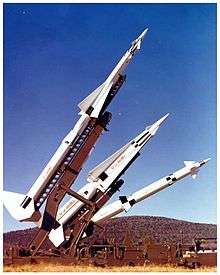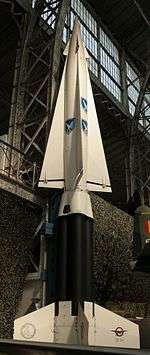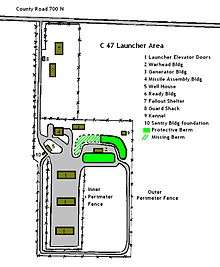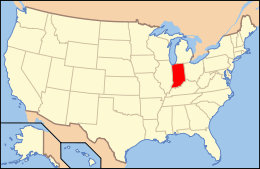Nike Missile Site C-47
Nike Missile Site C-47 is a former missile site near Portage, Indiana. The Nike defense system was a Cold War-era missile system in the United States. Nike missiles were radar guided, supersonic antiaircraft missiles. The planners hoped that Nike would make a direct attack on the U.S. so costly as to be futile.[2]
Nike Missile Site C-47 | |
 | |
  | |
| Nearest city | County Roads 600N and 700N, south of Portage, Portage Township, Porter County, Indiana |
|---|---|
| Coordinates | 41°31′24″N 87°10′40″W |
| Area | 29 acres (12 ha) |
| Architect | U.S. Army |
| Architectural style | Modern Movement |
| NRHP reference No. | 99001669[1] |
| Added to NRHP | January 21, 2000 |
Nike missile sites were constructed in defensive rings around major urban and industrial areas. Chicago was likely selected because of its population, the presence of several military bases, and the Gary, Indiana, steel industry.[2] Nike C-47 (Nike 1B, 1C/12H, 20A/12L-U, (8L-H)) near Portage designed with two units nearly a mile apart. The first section was the Launcher Area and is located on the south side of County Road 700 North, approximately 1/4 west of County Road 500 West, in Porter County, Indiana. The second area was the Control Area, located on the north side of County Road 600 North, near Wheeler. Sometimes called Administration Area. The base was operational by 1956, construction begun in 1954.[2]
Facility
 Building #2 and the Fallout Shelter
Building #2 and the Fallout Shelter Duty Barracks
Duty Barracks Missile Assembly Building
Missile Assembly Building Missile Elevator doors
Missile Elevator doors Radar Towers
Radar Towers Headquarters building
Headquarters building
Chicago–Gary Defense Area
The Chicago defensive area, one of the larger in the nation, had about 20 bases ringing metropolitan Chicago. Due to the relatively short range of the first generation Nike missiles bases had to be close to the area they protected.[2]

The Army began to buy land and build sites in the early 1950s. The basic system was operational by 1954. Newer Nike missiles extended the capability of the rings. The "Hercules" were nuclear capable and could destroy fleets of Soviet bombers over a wide area. These were deployed at a few selected sites. The Hercules could reach Soviet airspace to intercept aircraft. Hercules missiles had the potential to be used against ICBMs (intercontinental ballistic missiles). C-47 was one of the first Nike sites to receive the Hercules missiles.[2]

Related sites

- C-32 Nike 3B/12H, 20A/12L-U
- Porter, Indiana - Redeveloped for the offices of the National Park Service Indiana Dunes National Lakeshore. The launch site is a half-mile west. It is fenced, behind a locked gate, although largely intact. Privately owned, and overgrown.
- C-44 Nike 2B, 4C/60A/24L-AA
- Hegewisch /Wolf Lake, Illinois (dual site) - Abandoned and overgrown at the south end of recreation area. The access road entrance is at Ave J & 133 Street largely obliterated. The launch site is also abandoned. It is on the north shore of the lake, where S. Wolf Lake Blvd. becomes S. State Line Rd. The buildings are gone but foundations remain.
- C-45 Nike 2B/20A/8L-A
- Gary Municipal Airport, Indiana - Redeveloped area at the north tip of the airport. A general aviation hangar, parking lot and ramp area for aircraft parking were created. The former launch site is across Industrial Highway. The launch site was razed but remnants are still visible.
- C-46 Nike 1B, 1C/12H, 20A/12L-U, (8L-H)
- Munster, Indiana - Redeveloped into an industrial park. It is on the west side of Calumet Ave. N of 45th St. The launch site is on west side of Columbia Ave. It was razed in 2008, now in private ownership.
- C-48 Nike 2B/20A/8L-A
- Gary, Indiana - Redeveloped and abandoned from as an automobile dealership on Grant Street. The launch site was redeveloped into commercial/industrial site near NW corner of 35th Avenue and Grant Street.
Discontinuance
The Nike system protected the United States until 1972. The bases were closed in accord with the SALT treaty limits, and the onset of "détente".[2]
Significance
To be eligible for the National Register of Historic Places, Nike sites should be exceptional historically and retain a high degree of integrity, including all three major components: (1) administration, (2) radar, and (3) launch functions.[2] There are fifteen Nike sites in Illinois that are part of the Chicago-Gary Defense Area. Several have some buildings and launch areas. C-84 Palatine, Illinois was the last substantial site to be redeveloped.[2] Five of the bases in the Chicago ring were in Indiana. C-47 is the only site to retain all three functions. A few buildings remain at several of the bases in Indiana. The National Park Service uses several buildings from a base near the Chellberg Farm for offices and service buildings at Indiana Dunes National Park. As elsewhere, they are remnants of bases, not complete units. The early use of nuclear missiles on the site furthermore makes C-47 rare and exceptional site.[2]
Missile on display.
- A Nike Ajax and Hercules are on display in front of the VFW post in Cedar Lake, Indiana
- A Nike Ajax is on display near the Toledo Rockets Glass Bowl Stadium on the campus of the University of Toledo in Toledo, Ohio.
See also
- List of Nike missile sites
- Chicago-Gary Defense Area
- MIM-3 Nike Ajax
- MIM-14 Nike-Hercules
References
- "National Register Information System". National Register of Historic Places. National Park Service. July 9, 2010.
- "Indiana State Historic Architectural and Archaeological Research Database (SHAARD)" (Searchable database). Department of Natural Resources, Division of Historic Preservation and Archaeology. Retrieved 2016-06-01. Note: This includes Don Peterson (February 1998). "National Register of Historic Places Inventory Nomination Form: Nike Missile Site C-47" (PDF). Retrieved 2016-06-01. and Accompanying photographs.
Bibliography
- Bender, Donald E. Nike Missile Defense System Overview. Internet web page, bender@alpha.fdu.edu., online as of 1998.
- Carlson, Christina, Robert Lyon, Christine Whitacre, et al. Last Line of Defense, Nike Missile Sites in Illinois. Denver, CO: National Park Service, Rocky Mountain System Support Office, 1996. Center for Air Force History, et al. Coming in from the Cold, Military Heritage in the Cold War. U.S. Air Force, Legacy Program, June 1994.
- Lennox, Duncan. Jane's Strategic Weapons System. Surrey, United Kingdom: Jane's Information Group, 1990.
- Morgan, Mark L. and Mark Berhow. Rings of Supersonic Steel, Air Defenses of the United States Army, 1950-1979, An Introductory History and Site Guide. San Pedro, CA: Fort MacArthur Museum Association, 1996.

